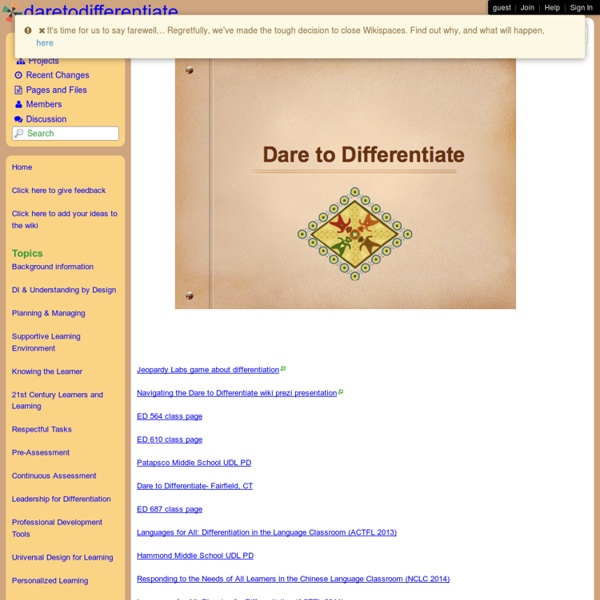



http://daretodifferentiate.wikispaces.com/
Ways To Differentiate Instruction - Classroom Q&A With Larry Ferlazzo (This is the first post in a two-part series on differentiation) I posed this question last week: "What is the best advice you can give to a teacher about differentiating instruction?" I've shared my response in an Ed Week Teacher article that I've co-authored with my colleague, Katie Hull Sypnieski. It's titled "The Five By Five Approach To Differentiation Success."
Great Infographic Making Tools for Teachers 1- Visual.ly This is my favorite tool. It helps you easily create awesome infographics using pre-designed templates. It also lets you create an infographic out of any Twitter Hashtag provided you are signed in which you can do using your Twitter account. 2-Easel.ly Integrating the 16 Habits of Mind In outcomes-based learning environments, we generally see three elements in play: 1) learning objectives or targets are created from given standards; 2) instruction of some kind is given; and then 3) learning results are assessed. These assessments offer data to inform the revision of further planned instruction. Rinse and repeat. But lost in this clinical sequence are the Habits of Mind that (often predictably) lead to success or failure in the mastery of given standards.
Top 10 Ways to Wake-up Students in Class - SimpleK12 The following is a guest post from Michelle Doman, a 7th and 8th grade Language Arts teacher at Brandon Middle School in Wisconsin. Top 10 Ways to Wake-up Students in Class Many people get a little squeamish, wiggly, and offer a scrunched expression when I respond to the question, “What grades do you teach?” I teach middle school, and with heart and honesty, I find great joys (and challenges) in teaching the group referred to as “tweens” and adolescents. So, I invite you into the quirky world of middle school. Do not fear…you will become comfortable in a beanbag, find a new young-at-heart-love-for reading air, and (at times chuckle) as I give you a sneak-peek into the crevices (oh, look out for that dirty sock) of the teenage minds.
Using Bibliotherapy with Gifted Children - Unwrapping the Gifted Hopefully we’ve all had that experience of reading a book that powerfully “spoke” to us, a book whose characters we could relate to, and whose struggles and triumphs we identified with. Taking this experience a step farther is the strategy of bibliotherapy, the process of helping the reader learn about and cope with any social or emotional struggles or developmental needs by identifying with a character in a book who shares a similar struggle or need. The reading is typically followed up by discussion with a trusted adult.
Advice for First-Year Teachers Advice for First-Year Teachers From the 'Sophomores' Who Survived Last Year Education World asked the "sophomores" who faced -- and survived -- that dreaded first year to reflect on their successes and failures. Differentiating the curriculum The Policy and implementation strategies for the education of gifted and talented students: Support package: Curriculum differentiation (2004) (pdf 1345kb) provides an introduction to curriculum differentiation for gifted and talented students and is suitable for all stages of schooling. It needs to be read in conjunction with the Policy and implementation strategies for the education of gifted and talented students (revised 2004) and its companion document (2004) (pdf 270kb). The purpose of differentiating the curriculum is to provide appropriate learning opportunities for gifted and talented students.
Good teachers use creative teaching methods - Educational Philosophy It’s never too soon or too late to start learning something new. Whether you’re just beginning your education or you’re a life-long learner, Education Space 360 has all of the information you’ll need to continue down the path of knowledge. Tips for parents with school-aged children Children are our future, and what they learn early on they’ll carry with them throughout their lives. Differentiating Instruction Differentiating Instruction ... One Size Doesn't Fit All Effective Strategies to Improve Student Performance ! We have students in our classrooms who struggle academically and others who learn at an advanced level and accelerated pace. We can meet the needs of all learners by differentiating instruction.
Teaching Strategies, Teacher Resources, Secondary Career Education, Glencoe, 2002 Teaching Strategies Your role as teacher is to create an environment in which all students can participate to the best of their abilities. One of your greatest challenges is to provide a positive learning environment for the students in your classroom. Because each student has his or her own unique set of physical and intellectual abilities, perceptions, and needs, the learning styles of your students may vary widely.
Guide to special needs apps Complete guide to educational and special needs apps With over 300,000 apps it's easy to become overwhelmed by the number of app choices. It's also easy to spend a small fortune on a lot of useless apps. As a special needs parent I wanted to get right to the "good stuff" and figured you did too. Check out our guide that breaks down the best of the apps by skill set so you can easily find and buy apps that most benefit your child.
Teaching Methods Each pedagogic approach is described succinctly so you can quickly understand how the technique might be relevant to your teaching. Written by fellow educators, these descriptions include tips for effectively using each technique, related research on their impacts on learning, as well as a set of example activities. This list is by no means comprehensive. It reflects the interests and priorities of the partners and projects that have contributed to the library so far.